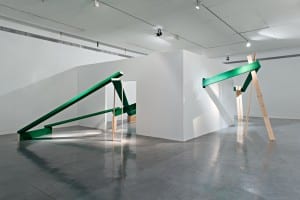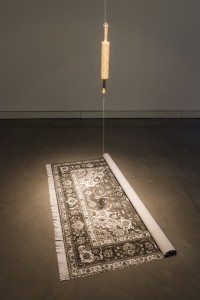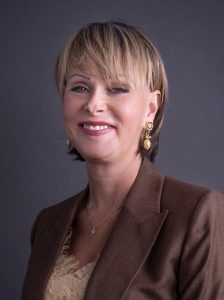Please scroll down for English
כשעומדים ליד, או בתוך, העבודה אינסוף שבור ומביטים באולם רחב הידיים של מוזיאון פתח תקווה יש תחושה ברורה של חדות, בהירות ודיוק, תחושה של קושי ואולי של קיצוניות. התערוכה של מיכאל גיטלין 16 עבודות היא שירה ולא פרוזה: בניסוחים קצרים ומהוקצעים הוא מדבר על שסעים ומאבק, על אשליות וצעיפי המציאות.

Broken Infinity Gitlin 2014
יש משהו מרענן באמנות העשויה ברובה קוים חדים שחוזרים בקרטון קרוע, עץ מנוסר או משיחות מכחול. במינימליזם החמור אין מסכי דימויים אינסופיים או התחכמויות מילוליות, אין חנופה ואין גם נחמה. האמנות של גיטלין לא מנסה למצוא חן או לשעשע .מה שהיה יכול בזמנו להיחשב סוג של מרד, הפך מזמן לחלק ממסורת האמנות המודרנית כך שההתבוננות בעבודות יכולה להיערך ללא רעשי הרקע של שאלות הקבלה או אי הקבלה שלה על ידי הזרם המרכזי. מיכאל גיטלין (1943) חי בניו יורק מאז שנות ה 70 אך מציג בארץ לעיתים קרובות למדי (לצד השתתפות בתערוכות קבוצתיות במוזיאונים הוא הציג מספר תערוכות יחיד בגלריה גלריה נ & נ אמן. הוא שייך לקבוצת האמנים הישראלים המינימליסטים שפעלו בשנות ה 70 בניו יורק לצד יהושע נוישטיין, בוקי שוורץ ואמנים נוספים ולמשך תקופה המקבילה לפריחה של המינימליזם יצרו נוכחות מרשימה על מפת האמנות הבינלאומית. בשנים שחלפו מאז המינימליזם הפך לאחת האופציות הסגנוניות של אמנות עכשווית. בפתח – תקווה גיטלין מוצג במיטבו בתערוכה של עבודות משנות ה70 וה 80 לצד עבודות חדשות.העבודה אינסוף שבור ניצבת במרכז התערוכה פיזית ורעיונית. זו גרסה חדשה שנבנתה עבור המוזיאון של עבודה שגרסה ראשונה שלה הוצגה בבון ב 1988, כלומר שנה לפני נפילת החומה, שנה לפני השינויים הגדולים שחלו ביחסי מזרח-מערב והמנדנדים עד היום. העבודה

Gitlin Broken Infinity
הנוכחית תוכננה למרחב המוזיאון והיא מגדירה ומאתגרת אותו, מתערסלת ודוקרת.
האיפיון הראשון שבולט לעין הוא הירוק הרענן, התמים, המבטיח בהם צבועות חלק מקורות העץ . הירוק הציורי כל כך אינו מתיישב עם החומרה המינימליסטית שמאופיינת בשימוש בעיקר בלבן או שחור והיא כמו רמיזה והכוונה לסוג של נרטיביות דקיקה , כמעט שקופה שנוכחת בעבודות הלכאורה ללא סיפור של גיטלין . חלקים של עץ לא צבוע תומכים בקורות הצבועות במערך של תמיכה שהוא כאין פיגומים . הטבעת חוצה קירות באופן שיותר תחושה של זרימה .
שם העבודה מתייחס ישירות ל Vertical Earth Kilometer (1977),גליל מתכת שמצוי מתחת לאדמה בקאסל, גרמניה ו The Broken Kilometer, 1979 (שמוצבת DIA בניו יורק) שתי עבודות מפתח של וולטר דה מריה שממחישות מרחק שהוא מדיד אך בדרך כלל אבסטרקטי בתפיסתנו.

דה מריה ממחיש סופיות ,מגמד את הדרמות האנושיות שנקשרות סביבו באופן בו הוא מציג אותו כחומר מושלם. האינסוף שגיטלין יצר הוא אינסוף שיכול להישבר, שזרימתו אינה חלקה אך יחד עם יש בה מידה של אנושיות , של מאבק , אם נרצה אפילו של חוסר אלגנטיות
.
בקטלוג כותבת האוצרת דרורית גור -אריה על העבודה כטבעת מוביוס (צורה דו-ממדית שיש לה צד אחד בלבד) שבורה,כסימן אינסוף שהשתבש “ניסיון כושל של האינסוף לרדת אל הארץ”. מענין לחשוב על העבודה , במידה רבה על התערוכה כולה שהרהור לא אורתודוכסי בזמן.לא מדובר ברטרוספקטיבה ובכל זאת שורטט בתערוכה היקף זמן נרחב , משנות ה 70 המאוחרות ועד היום, ובכל זאת מבחינה סגנונית ומחשבתית דומה שאין כאן מוקדם ומאוחר . גיטלין בוודאי השתנה ובכל זאת מעניין לחשוב על האמנות שלו לא כליניארית אלא כסוג של ספיראלה שהולכת וחוזרת מנושאים דומים .מבחינה זו הדימוי של טבעת מוביוס והאינסוף מובילים למבט אחר בזמן שיש בו גמישות .

. לבן על לבן לקזימיר
לבן על לבן לקזימיר , עבודה מ 2000, ענן מחר גפן סינטטי וספוג על שלד נחושת, צומח הקיר וכאילו מרחף לידו כמו בועת מחשבה עצבה-משעשעת ל מודרניזם . קזימיר, מלביץ כמובן, יצר ציור בשם לבן על לבן ב 1918 המצוי במומ”א בניו יורק. בציור ריבוע לבן המרחף בשדה צבע לבן , התגלמות השאיפה והאמונה של מלביץ שהמהפכה תוביל לרוחניות . גיטלין ממרחק שמונים שנה וידיעת הכישלון של המהפכה (וההיסטוריה המחרידה של המאה הקודמת) הופך ריבוע לענן שנראה כמו גידול , רך, על קיר המוזיאון , המקום שמבקש להיות אי של התכוונות לרוחניות. עניינים שבחומר קרא גיטלין לעבודה החדשה ביותר בתערוכה ,מוט פלדה שמתמשך בין ברזל יצוק לגוש עץ מהוקצע , שנראה כפרח שבראשו תפרחת שעלולה להכריע את גבעולו הדק. גיטלין משחק עם החומר , מודע היטב לכל התקדימים הפיסולים , וגם העיצובים, מברנקוזי ועד למנורהARCO של אקילה קסטליוני מ 1962 , ויוצר מערכת שמגששת למציאת איזון פנימי, חותרת נגד כוח המשיכה.
***
לצד התערוכה של גיטלין מוצגת התערוכה מידה כנגד מידה שאצרו דרורית גור אריה והילה כהן-שניידרמן. זו תערוכה של צלמים עכשוויים, אף שכמעט לא מוצגים בה תצלומים, אלא בעיקר אובייקטים פיסוליים. זו שיכולה להוות גרעין לתערוכה עתידית , והיא כאקספוזיציה לדיון בתרגום של צילום לחומריות בדיוק בנקודת הזמן בה הדימוי מתרחק מהחומרי. ב דבר ושום דבר בו זמנ

Same Time, Same Place Assaf Shaham
ית (2014) אסף שחם משתמש בשני מקרני שקופיות המקרינים שקופיות ריקות ברצף הקטוע והרועש לה משכשירים אלו כך שנוצרת חפיפה בין המה שניתן לכנות דימויי ריק בשקופית ה-40 במספר נוצר צלב אור המתפרק בשקופית הבאה. שחם בונה צלב, סמל רוחני מאור מכני ומנסח אמירה מושחזת על מודרניזם ואמונה, על רוחניות כתולדה של מנגנון מכני.
צירים של נעמה ערד הוא שטיח העשוי מניירות המוצמדים זה לזה בנייר דבק. השטיח מגולגל כתצלום, ומעליו תלוי מערוך מצופה חימר דמוי-בצק. מהשטיח הפרסי נשאבה הצבעוניות והחומריות לטובת צבעי השחור והלבן המאפיינים את עבודותיה ובמקום להיות אובייקט

Naama Arad
מרכך – מנחם הוא חלק מזירה טעונת אלימות.
עוד בולטות העבודות של מתן מיטווך היוצר מנגנון מורכב של אשליה והקרנה ; פלאוסול 80 דרום עבודות וידיאו אמיר יציב ויהונתן דובק על הר כרכום המזוהה כהר סיני המקראי; ועומרי (2014), של מארק יאשאייב של שומר מוזיאון המוצג על הקיר בחלל שבו צולם, וכך יצר מעין מנהרה בצרוף של מקום מושגי

Mark Yashaev
וקונקרטי.
מיכאל גיטלין 16 עבודות אוצרת דרורית גור -אריה
מידה כנגד מידה אוצרות דרורית גור אריה והילה כהן-שניידרמן
צילום: מידד סוכובולסקי
Michael Gitlin 16 Works , Measure for Measure
When standing near, or rather inside the installation Broken Infinity, looking into the spacious exhibition hall of the Petach Tikva Museum of Art, one senses a feeling of sharpness, clarity and precision, difficulty and perhaps extremism.

גיטלין אינסוף שבור 1988/2014
Michael Gitlin’s exhibition 16 Works is poetry, not prose: in short, well-crafted formulations, he speaks of jagged tears and struggles, illusions and veils of reality.There is something refreshing about Gitlin’s art, made mostly with sharp lines recurring in torn cardboard, sawn wood, or brushstrokes. The severe minimalism of the works needs no screens of infinite images or verbal pyrotechnics, no flattery and no consolation. What could have been seen as a rebellion at the time it was first exhibited has long ago become part of the tradition of modern art, so that these works can be observed without the background noise of the issue of acceptance or non-acceptance by the mainstream. Michael Gitlin (b. Israel, 1943) has been living in New York City since the 1970s, but exhibits in Israel quite often. (In addition to participating in group shows in museums, he has exhibited solo at the N & N Aman Gallery, Tel Aviv). Gitlin may be grouped with the Israeli Minimalists active in New York during the 70s, along with Joshua Neustein, Buky Schwartz and others, creating an impressive presence on the international art scene during the years when Minimalism flourished. Minimalism has since become just one of the stylistic options of contemporary art. The current exhibit features some of Gitlin’s best works from the 70s and 80s along with new works. Broken Infinity lies at the physical and philosophical center of the exhibition.  This is a new version of a work whose first version was exhibited in Bonn in 1988 – one year before the Berlin Wall came down and one year before the great changes in East-West relations still see-sawing today. The present version (2014), redesigned for the Petach Tikva Museum of Art, defines and challenges the space as it cradles and pierces it.The first striking visual quality meeting the eye is the fresh green paint on part of the wooden beams, such an innocent and promising color. The very painterly green is incompatible with the severity of Minimalism which celebrates mainly white or black, but is like a hint directing viewers to a thin, delicate narrative almost transparently present in Gitlin’s works but untold by him. Unpainted sections of the wood support painted beams in a scaffold-like system. The infinity ring passes through walls feels as if it is flowing.The title Broken Infinity is a direct reference to two key works by Walter de Maria, Vertical Earth Kilometer (1977), a metal cylinder underground in Kassel, Germany, and Broken Kilometer (1979), installed in New York City’s DIA Gallery.
This is a new version of a work whose first version was exhibited in Bonn in 1988 – one year before the Berlin Wall came down and one year before the great changes in East-West relations still see-sawing today. The present version (2014), redesigned for the Petach Tikva Museum of Art, defines and challenges the space as it cradles and pierces it.The first striking visual quality meeting the eye is the fresh green paint on part of the wooden beams, such an innocent and promising color. The very painterly green is incompatible with the severity of Minimalism which celebrates mainly white or black, but is like a hint directing viewers to a thin, delicate narrative almost transparently present in Gitlin’s works but untold by him. Unpainted sections of the wood support painted beams in a scaffold-like system. The infinity ring passes through walls feels as if it is flowing.The title Broken Infinity is a direct reference to two key works by Walter de Maria, Vertical Earth Kilometer (1977), a metal cylinder underground in Kassel, Germany, and Broken Kilometer (1979), installed in New York City’s DIA Gallery.

They concretize a measurable distance which is usually an abstract perception. De Maria illustrates finality, dwarfing human dramas as he exhibits the concept as perfect matter. Gitlin creates an infinity which can be disrupted, with uneven flow, but which has humanity, struggle and even a lack of elegance. Curator Drorit Gur Arie wrote in the catalog that the work is like a broken Moebius strip (a two-dimensional surface with only one side), a ruptured infinity symbol, “a failed attempt by infinity to come down to earth.” It is interesting to think about this particular work and the entire exhibition as an unorthodox contemplation of time. This is not a retrospective, but it nevertheless limns a considerable amount of time from the late 70s to the present, with stylistic and thematic similarities and no sense of what is early or what is late. Gitlin has surely changed, yet one may think of his work as non-linear, a kind of spiral leaving and returning to similar themes. The image of the Moebius strip and infinity lead us to a possible view of time as flexible.White on White for Kazimir (2000)

is a “cloud” of synthetic cotton wool and ethafoam on a copper armature growing out of the wall, seeming to hover near it like a sad/amusing “thought bubble” ( as in comics) on modernism. Kazimir (Malevich, of course), made his White on White in 1918, now at the MOMA in New York City: a white square hovers over a white paint field, the incarnation of his ambition and faith that the Revolution would lead to spirituality. From a distance of 80 years and with the knowledge of the failure of Communism (and, on the whole, the horrific history of the 20th century) turns the square into a soft growth on the Museum wall, on a site seeking to be an island of intention to spirituality. Material Matters (2013) the most recent work in the exhibition. A steel rod leads from cast iron into a block of planed wood, seeming to be a flowering top likely to topple its thin stalk. Gitlin plays with his material while fully aware of all of the sculptural and design antecedents, from Brancusi through Achille Castigliano’s1962 Arco lamp, as he creates a system engaged in finding an internal balance and undermining gravity
***.
Measure for Measure, curated by Drorit Gur Arie and Hila Cohen-Schneiderman, is an exhibition of contemporary photographers, although there are hardly any photographs on display. The sculptural objects being shown could constitute the nucleus of a future show as an exposition on a discussion of the translation of photographs into materiality, precisely at the point in time at which the image is becoming more and more distant from the material. In Same Time, Same Place (2014), Assaf Shaham

Same Time, Same Place Assaf Shaham
uses two slide projectors – projecting blanks. In the broken, noisy continuity from these appliances, an overlap is crated between what may be called an empty image. In the 40th slide, a cross of light is formed, only to break up in the next slide. Shaham makes the spiritual symbol of a cross out of mechanical light, formulating a sharp statement on modernism and faith, as an outcome of a mechanical mechanism.Axis by Naama Arad is a carpet made of papers stuck together with sticky paper. The carpet is rolled up as a photograph, above which hangs a rolling pin coated with batter-like clay. She draws all of the coloration out of the Persian carpet as well as removing its materiality, leaving the black and white which characterizes her works; instead of being a consoling object, it becomes part of an arena charged with violence.Other outstanding works are by Matan Mittwoch, who creates a complex system of illusion and projection; the video art by Amir Yatziv & Jonathan Doweck referring to Mt. Karkom, identified as the biblical Mt. Sinai; and Mark Yashaev’s Omri (2014),

Mark Yashaev
the museum guard. His photograph is hung on the wall in the space where he was photographed to create a tunnel with its combination of a conceptual with a concrete space.
Michael Gitlin 16 Works curated by Drorit Gur Arie
Measure for Measure, curated by Drorit Gur Arie and Hila Cohen-Schneiderman
Meidad Suchowolski photography






